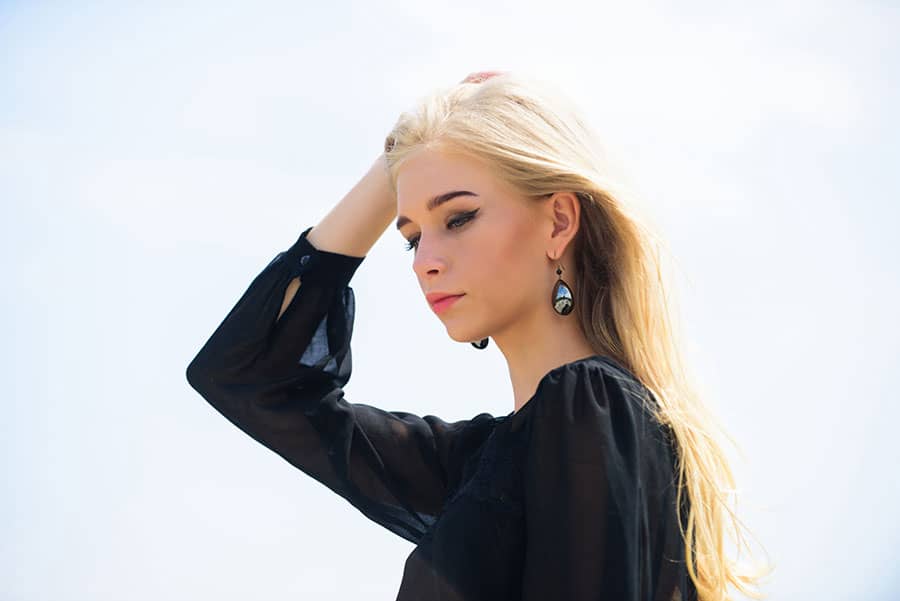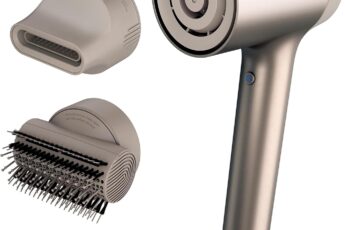
You finally got that platinum color you’ve dreamed of, but from all that bleaching your hair is now dull, damaged, and frizzy. Bleach can often cause these side effects, and thankfully, I have a few tips up my sleeve to help you out if you want to revitalize your hair. In this blog, you’ll learn how to fix damaged bleached hair and slowly restore it to its former glory.
Bleaching causes inevitable hair damage; however, when you treat your hair properly, you can lower that damage to a minimum. Before we talk about the 11 life-changing tips for ladies with bleach-treated hair, I’d like to first teach you more about the signs that point to hair damage.
You’ll also learn about the most common mistakes many people make that lead to damage after bleaching. Finally, I’ll go over how to fix that damage if your hair has fallen victim to these common mistakes.
Table of Contents
5 Signs of Badly Bleached Hair
1. Frequent Tangles
One of the common signs that your hair is damaged after bleaching is frequent tangles and knots. Although healthy hair can tangle too, bleached manes will face this problem much more often. Unfortunately, the bleaching procedure strips your scalp and hair of natural oils that prevent knots, so you’ll have to deal with them each time you brush your hair.
2. Dry, Lifeless Hair
Dull, dry, lifeless hair is the number-one bleaching side-effect so many people face. Once the bleach soaks into your hair, it removes the moisture from the cuticles, leaving the mane looking brittle and dry. In addition, this lightening technique interacts with the oils and minerals in your hair, tackles them, and causes a dull-looking finish.
Fortunately, there are many hair professionals that will do the procedure the right way, give you plenty of advice on how to strengthen your hair after bleaching, and you’ll know how to minimize and deal with the dryness.
3. Split Ends
Split ends happen even to hair that hasn’t been color-treated; however, they are even more pronounced in bleached hair. When exposed to bleach, your hair can become brittle, lose its natural moisture, and end up with split ends. This might not happen after the first bleaching sessions, but if you practice it frequently, damaged ends are a sign you should give it a rest.
4. Frizzy Hair
The dryness we mentioned before tends to go hand-in-hand with stubborn flyaways. Frizzy hair is frustrating even if it hasn’t been bleached, but when bleach gets in touch with the cuticle, it strips your hair from its natural oils. That’s the reason why it gets frizzy and hard to control.
5. No Shine
Bleach-damaged hair isn’t only dry and lifeless, but it usually also loses its natural shine. This all happens due to changes in the cuticle, so the natural shiny reflection you’re used to seeing will disappear after your mane is damaged by excessive bleaching. Hair cuticles are positioned flat, giving light and sun rays the chance to reflect off the surface and provide that alluring hair shine.
3 Common Mistakes That Lead to Damaged Hair After Bleaching

1. You Didn’t Schedule a Consultation Before the Bleaching Session
Scheduling a consultation with a professional stylist beforehand will help you get familiar with the technique, get advice from the hair colorist, and get a general idea if you like their work. Don’t hesitate to ask for pictures from previous clients and learn all about the disadvantages of this method.
2. You Shampoo Every Day
Washing your hair every single day is a big no-no! Applying shampoo too often will strip your hair of the natural oils, so your scalp and hair will get dry and flaky. Believe it or not, shampooing it once or twice per week is enough.
3. You Don’t Use Conditioner
Did you know that conditioning is an essential step in the hair care routine of color-treated ‘dos? Well, one of the mistakes so many people make is skipping the conditioner and only shampooing their hair. If you want a healthy, nourished hairdo, be sure to opt for rich conditioners that contain oils and moisturizing ingredients.
How to Fix Damaged Bleached Hair
Is it possible to fix your hair once you’ve noticed the signs of damage after a bleaching session? Unfortunately, you can’t turn back time and reverse all of the damage! However, you can nourish your hair with the tips we provide below and prevent the damage from getting even worse.
The best thing about your hair is that it will eventually grow out, so you’ll know better what to do the next time you decide to bleach it. Here are some tips to keep in mind to prevent future damage to your hair.
Be Gentle While Your Hair Is Wet
Wet, bleached hair is quite vulnerable, so your top priority is to learn how to take care of it using the right tools. Start by drying it with a microfiber towel and gently tap it until the excess water is gone.
When your hair is damp, use a wet brush to brush it. However, you should never brush your hair when it’s wet because you’ll cause even more breakage.
No More Bleaching
When you see signs of damage, it’s time to press pause on bleaching. Yes, you probably love how your hair looks, but do you want to risk damaging it even more? It might not be the tip you want to hear; however, the best thing you can do is at least minimize the frequency of bleaching sessions and give your hair some time to heal.
Protect It Before Bleaching
If this is your first time doing this procedure and you want to avoid damaged hair, this step should be at the top of your list.
Before going to the hair salon, be sure to use a rich protein hair treatment or mask to nourish your hairdo. You can also talk to your hairstylist and ask them if they offer similar treatments to get your hair as healthy as possible before exposing it to bleach.
Regular Trims
Regular trims are essential for everyone, especially for people with bleached hair. As we mentioned before, one of the common damage signs is split ends, which won’t go away unless you go for a trim to remove them. In addition, if you skip scheduling a session with your hairdresser, those ends will go up and get worse, damaging your hair even further.
This will eventually result in frizzy hair that appears unhealthy and is hard to tame. Getting a trim four times per year should be enough, but you can also schedule them more frequently to keep your hair as healthy as possible.
Avoid Chlorine
Chlorine is one of the worst enemies of bleached hair. But what happens when you bleach it during the summer, and you desperately want to take a dip in your pool? Unfortunately, we come bearing bad news.
If you can, you should stay away from the pool if you have bleached hair. When that’s not an option, you should rinse your mane very well after exposing it to chlorine and buy a chlorine-removing shampoo. You can also tie it up in a high bun and avoid getting it wet.
Make sure you don’t stay in the pool for too long, because your hair will be much more vulnerable when bleached.
First, it can cause your hair to turn a swampy shade of green, which you definitely don’t want if that’s not the color you’re aiming for. After that, the chlorine can make your hair so dry and lifeless that you’ll never want to go in the pool again.
6. Avoid Heat Exposure
We’re sad to say that you have to retire your straightening iron, curler, and hairdryer after bleaching your hair. The least you can do is reduce heat exposure to a minimum and only use tools when necessary. On the bright side, this is your chance to fall in love with your natural hair texture all over again!
Remember to apply a heat-protecting product each time you reach for a hot tool if you just can’t help yourself from using your flat iron.
7. Hydrate
If you want to know how to restore hair after bleaching, the answer is simple! The main thing your bleached hair needs is hydration, so your goal is to provide it via the right products. You can start with various hair oils, such as jojoba seed oil, coconut oil, shea butter, avocado oil, etc.
These oils are packed into many great products, including shampoos, conditioners, and hair masks. Adding nourishing ingredients to your hair care routine can completely change the way your mane looks.

8. Protect Your Hair from the Sun
Although protecting your hair from sun damage should already be a daily habit, this step becomes even more crucial the second you bleach it. Unfortunately, post-bleaching, your mane is even more sensitive to sun exposure, so grab all the SPF-reinforced hair products you can get and start protecting that gorgeous mane.
9. Use a Keratin Treatment
It doesn’t matter if you opt for a professional or an at-home keratin treatment as long as you get one. Keratin is amazing for bleached hair because it’s a protein that will condition it and make it shiny and stronger.
10. No Shampoo Right After Bleaching
Using shampoo on your freshly bleached hair is a huge no! Shampooing your hair after bleaching it will strip away all of its remaining natural oils, making the hair even dryer, more brittle, and lifeless. Wait for at least a day or two before shampooing it because your hair will be very sensitive after the procedure.
11. Use Silk Pillowcases
Even the smallest changes mean a lot when you want to learn how to heal bleached hair. Whether it’s bleached or not, one simple investment you can make for your mane is to get a silk pillowcase. Satin is another way to go, but silk is the premium, as it’s the gentlest choice that will reduce hair breakage to a minimum.
In general, when your hair rubs against other pillowcase materials, it gets frizzy and is more easily damaged, more tangled, and lifeless. Silk is a natural material that won’t cause any further breakage and will eliminate stubborn flyaways.
FAQs About Fixing Damaged Bleached Hair
Will bleached damaged hair grow back?
Yes, bleach damaged hair will grow back; however, you should be ready to wait for quite a while before you’re back to healthy hair. Generally, it takes between half a year and a year for bleached hair to grow back.
Another thing to keep in mind is that hair bleaching can cause hair damage in two ways. The first one is split ends and hair breakage, which require more frequent trimming. The second one is hair thinning that sometimes needs professional help from a trained doctor in severe cases. This is why preventing damage is so important!
Does coconut oil help bleached hair?
Yes, coconut oil is an excellent and inexpensive product that can rehydrate your bleached hair. You can apply it as a hair mask once a week or every two weeks.
Get a scoop of the oil, rub it between your palms, then apply it to your hair from the roots to the ends. Sleep with a shower cap overnight, then wash your hair the following day. Coconut oil is a great protective mask to apply before bleaching.
Is it normal to lose hair after bleaching?
Losing hair often happens after bleaching it. However, the way you’re losing it will let you know if you should ask for professional help or follow our tips on how to get your hair back healthy after bleaching.
When you notice hair breakage at the hair ends, or even mid parts, then you should be fine. But, if the hair starts falling out at the roots, then that’s an alarming sign. In that case, you should either go back to the salon or schedule an appointment with a doctor.
Hair Repair Unlocked!
Learning how to fix overly bleached hair is something you should do even before you’re ready to call the hair salon. Your new hairstyle will require a lot of dedication, excellent hair care, and a lot of sacrifices.
After bleaching it, your top priority should be to hydrate it with adequate hair products (shampoo, conditioner, and a good-quality mask). Next, apply a keratin treatment when you get a chance and practice regular trims. Be gentle with your hair when drying it and brushing it to prevent further damage.
Finally, stay away from heat exposure, avoid chlorine, avoid bleaching in the near future, and don’t shampoo your hair for at least a day or two after the procedure.
0


